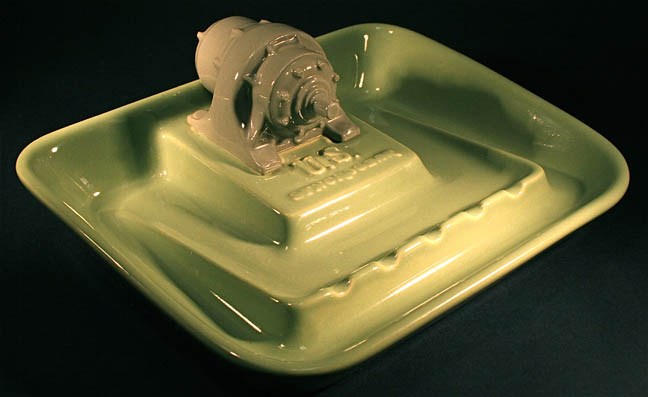

Title: Industrial Clay Ceramic Glazed Pottery Motor Advertising Ashtray
Shipping: $39.00
Artist: N/A
Period: Contemporary
History: N/A
Origin: N/A
Condition: Excellent
Item Date: 1940 to 1960
Item ID: 3455
This is a industrial Ceramic green colored glaze motor ashtray. Limited Edition Commemorative Issue that could have been produced as a gift. This looks to be from the 1940s 1950s some kind of Motor Company. Mounted in what appears to be all ceramic design. It is in excellent condition! Very cool and signed U.S. and it was made in China. 1950's WESTERN LAND ROLLER POTTERY ASHTRAY: This is what was found out about this piece: This is a UNIQUE PIECE OF ADVERTISING POTTERY from the 1950's and perhaps the late 1940's. In the 1940's and the 1950's the pottery companies were struggling greatly to survive. Many of them sought business by making pottery ad pieces at a very attractive price. As time continued and as the manufacturing of plastic was perfected - companies turned to plastic because of the durability and the cheap prices. Eventually, plastic and the mass appeal of plastic in the late 1950's and 1960's was the doom of most pottery companies. Thus, it is always nice to see vintage pottery ad pieces. This piece of advertising pottery was made for a pioneer COMPANY. This is an advertising ashtray made by pottery. Then it flows out into a large ashtray. This was kept on the desks of company Executives and this was given out to dealers and Key Customers as a gift. Very nice and unique piece of pottery that is still in excellent shape. Shawnee and Abingdon made quite a few ad pieces for companies. It looks similar to their style - but that is just one opinion.
http://en.wikipedia.org/wiki/Pottery
Pottery is the ceramic ware made from clay by potters. Major types of pottery include earthenware, stoneware, and porcelain. The places where such wares are made are called potteries. Pottery is one of the oldest human technologies, and remains a major industry today. Pottery is made by forming a clay body into objects of a required shape and heating them to high temperatures in a kiln to induce reactions that lead to permanent changes, including increasing their strength and hardening and setting their shape. There are wide regional variations in the properties of clays used by potters and this often helps to produce wares that are unique in character to a locality. It is common for clays and other minerals to be mixed to produce clay bodies suited to specific purposes. Firing produces irreversible changes in the body. It is only after firing that the article can be called pottery. In lower-fired pottery the changes include sintering, the fusing together of coarser particles in the body at their points of contact with each other. The atmosphere within a kiln during firing can affect the appearance of the finished wares. An oxidising atmosphere, produced by allowing air to enter the kiln, can cause the oxidation of clays and glazes. A reducing atmosphere, produced by limiting the flow of air into the kiln, can strip oxygen from the surface of clays and glazes. This can affect the appearance of the wares being fired and, for example, some glazes containing iron fire brown in an oxidising atmosphere, but green in a reducing atmosphere. The atmosphere within a kiln can be adjusted to produce complex effects in glaze. Kilns may be heated by burning wood, coal and gas, or by electricity. When used as fuels, coal and wood can introduce smoke, soot and ash into the kiln which can affect the appearance of unprotected wares.